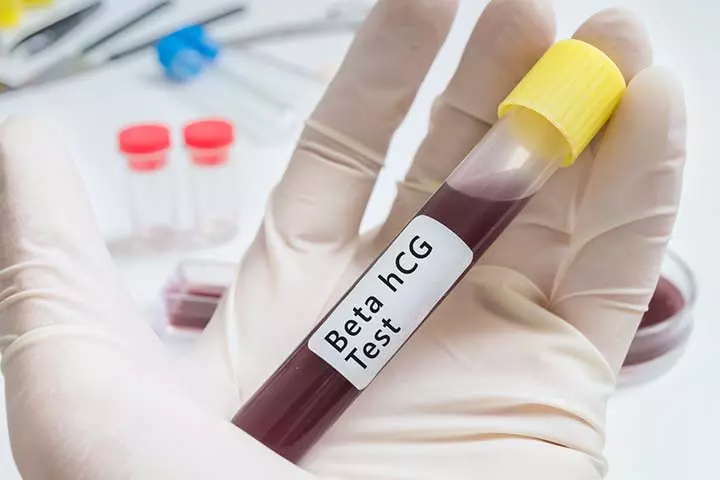
Image: Shutterstock
A threatened miscarriage or abortion is defined as vaginal bleeding during the first three months or by 20 weeks of pregnancy

. According to StatPearls Publishing in the National Library of Medicine, vaginal bleeding during the first trimester is seen in 25% of women, among whom 50% tend to progress toward early pregnancy loss. After a threatened abortion, some women may have a healthy pregnancy, while others may have a miscarriage or pregnancy loss.
If you have a threatened pregnancy loss, you may need the help of a healthcare expert to figure out what’s causing it and come up with a treatment and management plan.
Read on to know more about the causes, risk factors, symptoms, complications, and management of threatening abortion.
Key Pointers
- Threatened miscarriage may be caused by infections, molar pregnancy, alcohol use, and diabetes.
- Symptoms include vaginal bleeding, spotting, blood clots, and pain in the lower back or abdomen.
- A higher risk of threatened miscarriage is associated with infections, trauma, medication, or advanced maternal age.
- It may lead to complications such as maternal anemia, infections, and miscarriage.
- Medications, such as antibiotics, and adequate rest are some ways to treat the condition.
Causes Of Threatened Abortion
The common causes of a threatened miscarriage, which is vaginal bleeding, may include (1) (2):
- Infections
- Miscarriage
- Molar pregnancy
- Chronic illnesses, such as diabetes, high blood pressure, and thyroid problems
- Alcohol use
- Recreational drug use
- Uterine factors – septum, fibroids, polyps
- Cervix is incompetent and cannot hold the pregnancy
- Genetic causes like abnormal embryo
- Immunological cause
Early pregnancy bleeding can be due to minor issues in the uterus, cervix, vagina, or the external genitalia. It can often be due to implantation or irritation that may occur after sexual intercourse.
Fetal problems such as chromosomal abnormalities may cause threatened miscarriage or miscarriage in the first trimester (first three months) of pregnancy. In contrast, second-trimester miscarriages can be due to maternal factors such as diabetes, hypertension, ibroids malformation of uterus, etc.
 Things to know
Things to knowSymptoms And Signs Of Threatened Abortion

Vaginal bleeding is the main symptom of threatened miscarriage, and it can be light or heavy bleeding. Some women may experience cramping or abdominal pain during pregnancy, along with bleeding (2).
You may have light spotting or heavy blood loss, blood clots, and may feel pain in the pelvis or lower back.
Duration of vaginal bleeding during threatened miscarriage may vary in each pregnant woman, depending on the causing factor. You may contact your doctor if you are experiencing vaginal bleeding during pregnancy, even if light or without belly pain.
Risk Factors Of Threatened Miscarriage
The risk factors for threatened miscarriage can be high in the following situations (2).
- Presence of infections
- History of trauma
- Usage of certain medications
- Advanced maternal age
- Previous history of abortions
In case of high fever during pregnancy or other illnesses, you may seek medical care. Always take medications and supplements that are safe during pregnancy.
Complications Of Threatened Abortion
Possible complications of threatened abortion may include the following (3).
- Moderate and heavy bleeding may result in anemia

- Increased risk for infections
- May result in miscarriage
The complications may vary depending on the causes.
When To Call A Doctor For A Threatened Miscarriage?
You may seek medical care if you are having any symptoms of threatened miscarriage. Early diagnosis and treatment may give better outcomes.
It is recommended to seek your doctor’s advice and have prescription medication for any health concerns or illnesses during pregnancy.
How Is A Threatened Miscarriage Diagnosed?
Your doctor may diagnose threatened abortion based on your symptoms and medical history, along with physical examination (pelvic exam) to confirm vaginal bleeding. The following tests can be ordered for a detailed analysis of fetus and maternal status (4).
- Blood tests: These may help identify the levels of pregnancy hormone, human choriogonadotropin (hCG), and any anemia or B sugar. It may also help determine the blood type and administer RhoGAM medicine to prevent blood interaction with the fetus if you are RH negative with a partner who is RH positive blood type.

- Urine tests: Urinalysis is often helpful in identifying urinary tract infections (UTIs) or asymptomatic bacteriuria (bacteria in the urine).
- Ultrasound: Ultrasound of pelvis can be done to look at the fetus and placenta. It may help assess the presence of fetus, location of pregnancy (ectopic pregnancy), and any other abnormalities.
- Fetal heart monitoring: Fetal heart rate is seen.
Your doctor may also order a few other tests based on your health status and cause of threatened miscarriage. Follow-up visits may involve extra tests, like blood tests to check hCG levels, to assess the health of the pregnancy. Regular check-ups are important to monitor progress and ensure proper care.
Threatened Miscarriage Treatment
Many pregnant women can get well without any treatment if they have light spotting or not lasting bleeding. However, a few pregnant women may require some interventions to continue the pregnancy. This may include (4):
- Medications, such as progesterone hormones given to continue the pregnancy. This female hormone supports a pregnancy.
Amy Kiefer, a mom of three, shares her threatened miscarriage experience. She writes, “Three years ago, sitting with my 15-month-old son and my husband during a long layover, on our way back home from Norway, I felt a sudden gush of warm blood… I was only six weeks along and certain I was miscarrying… The bleeding tapered off by the next morning. I had no pain or cramping, so I had little fear of an ectopic pregnancy. And I still felt pregnant: nauseated, tired, and lightheaded.
“I called my OB, but they could not fit me in for another five weeks… I found another OB. My new OB ran tests. My HCG levels were normal, but my progesterone was low, perhaps because of the nearly constant breastfeeding, the lack of sleep, and the stress. She could not say for sure. She prescribed progesterone supplements for the rest of my first trimester… Although I will never know for sure, my OB may have saved my pregnancy (i).”
- Rho immune globulin, which is given if the mother has Rh-negative blood type and prevents interaction with fetal blood through the formation of antibodies against fetal blood.
- Bed rest and minimal activity, along with medications, in case of heavy bleeding.

- Fluid and electrolyte replacement by intravenous fluids or blood transfusion, sometimes required in severe blood loss and dehydration.
- Antibiotics prescribed to treat bacterial infection.
- Control of Maternal diabetes, hypertension, and hypothyroidism
- Pain medications, if required.
It is essential to seek medical care to safeguard your pregnancy in a threatened miscarriage. Your doctor can identify the cause and give relevant treatment to manage the condition.
Is A Surgery Required For Threatened Miscarriage?
Not all women who undergo threatened abortion require surgical procedures. If there is cervical incompetence (weakness of cervix), then cervical cerclage (cervical stitch) is done. This is usually done in the second trimester of pregnancy.
Note: Dilation and curettage (D & C) procedures are done after the miscarriage to clear any remaining products of conception in the uterus (5). This may often be delayed in the presence of pelvic infection and contraindicated in clotting disorders and other medical problems.
What Is The Long-term Outlook?
The prognosis of threatened abortion may vary based on maternal and fetal health status and etiologic factors (causes).
More than 50% of threatened abortion or vaginal bleeding occurs in the first 12 weeks of gestation, but most women continue to have a healthy pregnancy (4). However, others can have continued bleeding that may often end in a miscarriage.
Pregnant women with threatened miscarriages have an increased miscarriage risk than others. Seek medical care if you have any vaginal bleeding or discomfort during pregnancy.
To achieve the best outcomes, try to follow a healthy lifestyle, listen to your doctor’s advice, and go to regular prenatal checkups.
 Point to consider
Point to considerPrevention Of Threatened Miscarriage
Prevention of threatened miscarriage may not be possible in all cases. However, proper prenatal care could reduce the risk (3).
Proper management of diabetes and hypertension (high blood pressure) during pregnancy and early treatment of infections can be helpful. You should also avoid recreational drugs, over-the-counter medications, smoking, and alcohol during pregnancy since these may lead to first trimester bleeding and other pregnancy complications.
You may also take recommended vitamin and mineral supplements, such as iron supplement or folic acid supplement, as per the gynecologist’s prescription to reduce the risk of miscarriage and to promote a baby’s health.
 Quick tip
Quick tipWhat Should You Do After A Threatened Miscarriage?
If you experience threatened miscarriage or miscarriage, then the first thing to do is to seek medical care. The below-listed suggestions can be followed after a miscarriage (6).
- Take rest to feel better
- Do not insert tampons into the vagina
- Do not douche vagina with chemicals or any other products
- Avoid sexual intercourse until you are well
- Visit the emergency room if you have a high fever, cramping, heavy bleeding, or miscarriage.

Frequently Asked Questions
1. What are the chances of surviving a threatened miscarriage?
According to experts, “most women with a threatened miscarriage go on to have a normal pregnancy. Women who have had two or more miscarriages in a row are more likely than other women to miscarry again (7).”
2. Where does the blood come from in a threatened miscarriage?
In a threatened miscarriage, the blood may come from the implantation site. When the placenta tries to burrow itself in the womb lining, it may cause some blood vessels of the womb to rupture. Alternatively, trauma to the cervix and vaginal infections, such as thrush, may cause bleeding. In such cases, the blood discharge will appear more like spotting than bleeding (8).
3. How long does a threatened miscarriage last?
In most cases, the bleeding associated with a threatened miscarriage settles within a few days. However, if a subchorionic hematoma is detected, bleeding may occur periodically until around the second trimester (10).
4. Do hCG levels drop with threatened miscarriage?
A group study illustrated that decreasing hCG levels with advancing gestational age were noticed in women with adverse outcomes after a threatened miscarriage (11). However, it is essential to note that hCG levels can vary significantly during early pregnancy, and a single measurement may not provide conclusive information about the viability of the pregnancy (12).
5. How often do threatened miscarriages happen?
Threatened miscarriages are relatively common during early pregnancy. Although exact frequency may vary, research studies suggest that approximately 25% of women experience threatened miscarriage symptoms, such as vaginal bleeding or abdominal pain during the first and second trimesters of pregnancy (4).
6. How does threatened miscarriage affect pregnancy outcomes?
The outcome of a threatened miscarriage can vary. Sometimes, the pregnancy may progress successfully to full-term without further complications. However, in other instances, a threatened miscarriage can progress to an actual miscarriage or increase the risk of certain complications, including placenta previa, premature rupture of membranes (PROM), and preterm birth (13).
7. Can a threatened miscarriage be misdiagnosed?
A threatened miscarriage may sometimes be misdiagnosed, as the symptoms may overlap with other conditions. It is important to consult a healthcare professional experienced in managing pregnancy-related issues to ensure an accurate diagnosis and appropriate management.
8. What is the difference between a threatened miscarriage and an actual miscarriage?
A threatened miscarriage refers to the occurrence of symptoms that indicate a potential risk to the ongoing pregnancy, such as vaginal bleeding or abdominal pain. An actual miscarriage, on the other hand, involves the loss of the pregnancy (9).
9. How can a woman cope with the emotional impact of a threatened miscarriage?
Threatened miscarriage may be emotionally challenging for a woman, particularly when accompanied by intense symptoms or complications. Seeking emotional support from loved ones, friends, healthcare providers, and professional counselors could help address the challenges associated with such pregnancies.
Any unanticipated bleeding or alarming symptoms must be evaluated promptly during pregnancy as it could indicate complications such as a threatened miscarriage. Also, you may undergo all necessary tests and attend a follow-up visit to comprehend your and your unborn baby’s health status. Many women continue to have a healthy pregnancy after a threatened miscarriage; however, it largely depends on the severity of underlying causes, the effectiveness of treatment interventions, and prenatal care. Furthermore, discuss the preventive strategies with your doctor to reduce the risk of miscarriage and promote a healthy pregnancy.
Infographic: Risk Factors And Prevention Of Threatened Abortion
Understanding the risk factors associated with threatened abortion is crucial for expectant mothers. The following infographic aims to shed light on the potential factors that increase the chances of experiencing a threatened abortion. We have also included some preventive measures to help minimize the risk and promote a healthy pregnancy.
Some thing wrong with infographic shortcode. please verify shortcode syntaxIllustration: Threatened Miscarriage: Causes Symptoms And Risk Factors

Image: Dalle E/MomJunction Design Team
A threatened miscarriage is an unfortunate experience. Learn more about the signs, causes, and treatments in this informative video.
Personal Experience: Source
MomJunction articles include first-hand experiences to provide you with better insights through real-life narratives. Here are the sources of personal accounts referenced in this article.
i. A Threatened Miscarriage, a Subchorionic Hematoma, and How United Airlines (Nearly) Ate My Baby; https://caheo.info/2016/01/13/a-threatened-miscarriage-a-subchorionic-hematoma-and-how-united-airlines-nearly-ate-my-baby/References
1. Spontaneous abortion; MSD manual
2. Threatened Miscarriage; Beth Israel Lahey Health; Winchester Hospital
3. Miscarriage – threatened; MedlinePlus; The United States National Library of Medicine
4. Michelle Mouri and Timothy J. Rupp.; Threatened Abortion; The United States National Library of Medicine
5 Dialatation & Curettage (D&C); St. Clair Health
6. I Szabo and A Szilagyil; Management of Threatened Abortion; The United States National Library of Medicine
7. Miscarriage – threatened; Mount Sinai
8. What is a threatened miscarriage?; NHS
9. Miscarriage; Cleveland Clinic10. Miscarriage-threatened; Mater Mothers’ Hospital11. Abdulrazak H. Alnakash et al.; Outcome of the First Trimester Threatened Miscarriage: Study of the Predicting Factors; The Iraqi Postgraduate Medical Journal12. Gerald Konrad; First-trimester bleeding with falling HCG; The United States National Library of Medicine13. Ubong B Akpan et al.; The Influence of Threatened Miscarriage on Pregnancy Outcomes: A Retrospective Cohort Study in a Nigerian Tertiary Hospital; The United States National Library of Medicine
Community Experiences
Join the conversation and become a part of our nurturing community! Share your stories, experiences, and insights to connect with fellow parents.
Read full bio of Dr. Surveen Ghumman Sindhu
Read full bio of Dr Bisny T. Joseph
Read full bio of Rebecca Malachi
Read full bio of Reshmi Das
















